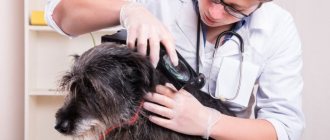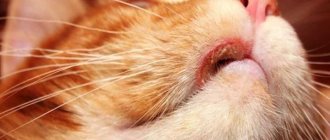Vasculitis
Vasculitis is an inflammation of blood vessels caused by a disorder of the animal's immune system. The body begins to attack itself, because of this, small vessels are destroyed and bruises and wounds appear on the skin, quickly healing with brown crusts.
The first organ to show signs of the disease is almost always the ears, since the small blood vessels in them run very close to the surface. This problem can affect any dog, regardless of age or gender. Veterinarians have not identified any statistics indicating that young animals get sick more often than older ones.
Symptoms of vasculitis:
- Small wounds on the tips of the ear, covered with crusts.
- Redness of the affected areas.
- Hair loss in areas of redness and vascular damage.
- Gradual swelling of the development focus.
- The appetite decreases sharply, causing the dog to rapidly lose weight.
- Severe pain.
- Periodic febrile seizures that go away on their own after a short time.
Vasculitis itself never occurs; in essence, it is rather the body’s reaction to a more serious problem.
The development of vascular inflammation can be provoked by:
- Some types of infections.
- Development of autoimmune diseases.
- Reaction to the administration of certain medications. Quite often it occurs either after vaccination with a new vaccine that has not yet been tested by this dog, or after using self-prescribed medications.
A huge problem for owners is an accurate diagnosis, since when contacting a veterinarian with such symptoms, the possibility of infection by parasites is first checked, and only after that research begins to help establish the true cause of what is happening:
- Analysis of urine.
- Complete blood test.
- Biochemistry of blood.
- X-ray or ultrasound examination of internal organs is carried out immediately after confirmation of suspicion of vasculitis, as this is the only way to determine the degree of neglect of the process and the damage caused to it.
Vasculitis is only a symptom of another, more dangerous disease, so you can get rid of it only after identifying the root cause and curing it.
At the same time, it is almost impossible to cure a dog at home on your own, since complex therapy using a number of drugs is required.
Otodectosis
Ear mite damage is one of the most common causes of problems in domestic purebred dogs, since they have a much weaker immune system that does not protect against parasites. Even an animal that is not outdoors but comes into contact with other animals can become infected.
Almost all stray dogs are affected by this parasite.
Microscopic insects, falling on the inner surface of the auricle, bite under the skin and gnaw passages in it, feeding on particles of the epidermis and bloody secretions. Because of this, crusts and sores begin to form on the tips of the ears, and brown scabs appear, which are waste products of mites.
If the onset of infection is not noticed in time, then over time it will lead to the development of otitis media, and in particularly advanced cases it can provoke replenishment of the brain. Therefore, when you see the first mild signs of infection, you need to start taking action.
Additional signs of ticks are:
- Constant itching, disturbing the dog and forcing it to scratch the sore spot on all possible surfaces.
- Unpleasant smell.
- The appearance of sores and a gradual increase in their number.
- Too much dirt in the affected area.
When you contact the clinic, the doctor will take a scraping of the affected area of the skin and conduct the necessary examination, and then prescribe antiparasitic drugs and ointments.
If there is no opportunity to seek help at the moment, you can stop the proliferation of parasites by treating the sores with hydrogen peroxide, moving the pet to more comfortable conditions and increasing the diet.
Analysis of the reasons for the appearance of crusts on the ears
The disease mainly affects short-haired pets that lead an active life and are exposed to environmental influences.
The most common reasons:
Long-eared pets are most often injured Hunting dogs get into fights with animals, scratch themselves on thorny plants and burrow arches. If dogs live in apartments, they still manage to get injured while walking. Minor abrasions and scratches heal unnoticed by the owner. If a dog accidentally picks off a scab, ichor is released and crusts begin to appear. Treat the defect with any antiseptic spray, which a responsible dog breeder should always have in his first aid kit. If the dog itches, picks off scabs, or bleeds at the tip of the ear, don’t take risks, visit the veterinarian.
Vasculitis is an inflammation of the capillary walls. Experts consider the disease to be an autoimmune disease. Initially, small blood vessels are affected, of which there are many at the tips of the ears. Skin tissues do not receive nutrition and die. The new epidermis does not have time to form, and a wound surface forms. The secreted ichor dries out and crusts form. Pathology has a predisposition to relapse. Characterized by the following symptoms:
- formation of ulcers;
- swelling;
- hair loss;
- touching the ear is painful.
The disease is distinguished by its duration and lack of improvement. If you notice that regular antiseptic sprays or powders do not work, contact a specialist.
Vasculitis
Dermatosis of the edges of dog shells occurs mainly in dachshunds and other dogs with drooping ears. Develops in puppies and old dogs, apparently due to weakened immunity. In most cases, the cause cannot be determined, which is why the dermatosis is called idiopathic. The edges of the shell, covered with scabs, hypertrophy, and with the transition to chronic inflammation, alopecia develops. The skin cracks and peels off. Sores form, the dog shakes its head. The width of the cracks increases, exudate is released, hardens, crusts form, and the tips of the ears peel off. There are no other symptoms for dermatosis.
Dermatosis of the edge of the ears
Sarcoptic mange is scabies caused by a microscopic mite. Dog breeders confuse the disease with otodectosis, however, the ear mite affects the inner surface of the shell, and Sarcoptes is located on the outside. The arthropod parasitizes the part of the skin rich in nerve endings, so itching is felt immediately after the dog is infected. At the first stage, patches of baldness appear on the face and ears. If treatment is not started in time, the disease will quickly spread to the entire surface of the body. Areas of hairless skin, ulcers, fistulas, and ulcers form. Therefore, if you notice the signs mentioned above, contact your veterinarian. Ticks can attack humans and cause short-term itching in children and the elderly.
Sarcoptes
Ectoparasites - fleas that pester the dog in the summer; lice and lice-eaters become more active in the winter, when their competitors - fleas - lose activity. The result of arthropod activity is dermatitis. The tips of the ears, fur and skin are affected. Lice and fleas feed on ichor. Lice eaters secrete a sticky secretion, form tangles, inside which they create ideal living conditions.
Attack of flies. The disease develops in summer. It is mainly the chain dogs and dogs guarding the estate that suffer. The diet consists of porridge, as well as category II offal. The feed mixture does not contain vitamins, complete proteins, or omega 3;6 fatty acids. The development of the disease is promoted by heat and dryness. When it dries out and cracks, ichor is released, which attracts burner flies. They eat away at the tips of the ears, causing unbearable suffering to the dog. Most often, symmetrical sores form on shells. If nothing is done, the flies will lay eggs in the skin defects, and the developing larvae will aggravate the suffering.
Microsporia affects the skin, mainly of older dogs with immunity weakened by chronic pathologies. The disease is promoted by keeping the pet in a damp room, as well as prolonged antimicrobial therapy with antibiotics. The fungus affects the hairs, they become thinner, break off and appear as if they have been trimmed. Therefore, the second name for the disease is ringworm . The first foci of alopecia appear on the tips of the ears and muzzle. If you suspect lichen, take your pet to a hospital.
The allergy is characterized by itchy skin rashes. The dog scratches the affected surfaces, they become covered with crusts. Most often, shells react to food irritants.
Lichen
The most dangerous disease. And we are talking here not only about the pet, but also about its owner, since a person can also become infected.
The onset of the disease can be determined by rapidly manifesting signs:
- Constant itching of the affected areas . At the same time, in trying to scratch itself, the dog spreads the infection to an increasingly larger area of its own body.
- Baldness of damaged areas.
- Crusts appear , which then change into cracks and ulcers that release blood.
If even the first symptoms appear, it is necessary to immediately isolate the pet from other residents of the house and take it to a veterinary clinic for examination and treatment.
Allergy
Often, ear sores appear as a sign of a full-blown allergy caused by an unsuitable food product, care product or medication. Even a previously unused vaccine can provoke the onset of an allergic reaction.
Identifying the problem is quite simple:
- Redness occurs on both the inside and outside of the ear.
- Constant itching forces the dog to inflict unnecessary wounds on itself.
- General swelling appears.
- Discharge from the eyes.
If you are absolutely sure that the cause of your poor health is an allergic reaction, then you can get rid of it with the help of antihistamines and by eliminating contact with the thing that causes such symptoms.
A dog has crusts on its ears: Causes
- Infectious (Pyoderma, Dermaphytosis, Dermatitis caused by Malassezia, Leishmaniasis).
- Allergic (Flea allergic dermatitis, Atopy, Food hypersensitivity, Contact dermatitis).
- Endocrine (Hypothyroidism, Hyperadrenocorticism, Imbalance of sex hormones, Diabetes mellitus).
- Parasitic (Demodectic mange, Scabies, Cheyleteiliosis, Otodectosis).
- Nutritional (Vitamin A dependent dermatosis, Zinc dependent dermatosis, Nutritional imbalance).
- Metabolic (Malabsorption, Superficial necrolytic dermatitis).
Like this article? Read other materials on our site: Changes in the mammary glands in a dog: Causes, diagnosis and treatment – Glands under the dog’s tail: Rules of care, problems and solutions – https://strazhchistoty.ru/cleanup/cleandogs/zhelezy-pod-hvostom-sobaki. html
Treatment at home
In some cases, it is not possible to contact a veterinary clinic immediately after detecting symptoms. But this is not a reason to leave a dog with wounds on the tips of its ears without help. There are several ways that can improve your pet’s situation before receiving qualified help:
- A regular pharmacy sells birch tar . You can lubricate the wounded area with it several times a day, this will protect the animal from infection and contribute to a speedy recovery.
- Tar can be replaced with Vishnevsky ointment , which has the same effect.
- Also, in order to protect the animal from infection and the spread of infection, it is necessary to wash the lesions with a solution of furatsilin , and then treat them with streptocide on top.
- If you know for sure that the wounds are the result of mechanical damage (a fight or an unsuccessful fall), then treat the damaged surface with hydrogen peroxide and anoint it with brilliant green.
- If you suspect an allergy, you need to review your diet. Until the exact cause is determined, exclude all cereals and most vegetables from your daily menu. Potatoes are considered especially dangerous.
All of the above measures will only help to avoid the spread of infection and deterioration of the animal’s condition. Even if they give a positive result, it will still be necessary to contact a veterinarian to determine the exact cause of the condition and prescribe the necessary treatment.
Dog Has Crusts on Tips of Ears: Clinical Signs
Dermatosis of the ear margins is quite common, especially in dogs with floppy ears, particularly dachshunds. At first, the edges of the ears thicken, become greasy and sticky, and hair rolls off (find out how to properly clean dogs' ears ).
When the process becomes chronic, the edges of the ears may become bald, ulcerated, covered with crusts, and cracks. Lesions with cracks can be painful, causing the dog to frequently shake its head, which aggravates the condition.











